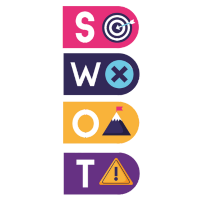In the world of marketing and SEO, creativity is an invaluable resource. To stand out in a competitive market, it is essential to generate innovative ideas that will propel your business to success.
One of the most powerful tools to stimulate creativity is Brainstorming.
We will explore this technique in depth, from its fundamentals to advanced methods for generating ideas effectively.

How to do a Brainstorming session
Basic principles
Brainstorming is a technique based on generating ideas in a collaborative and non-judgmental environment. Here we explain how to do it:
- Gather a diverse group of people.
- Set a clear objective for the Brainstorming session.
- Encourage participants to share any ideas, no matter how far-fetched they may seem.
- Encourage the construction of ideas from others’ suggestions.
- Use visual tools, such as whiteboards or post-its, to record ideas.
Implementation scenarios
Brainstorming can be applied in a wide variety of situations, from planning marketing campaigns to solving business problems. Specific examples of its use include:
- Content generation for blogs and social networks.
- SEO strategy development.
- Creation of product or service names.
- Addressing operational challenges.
What is Brainstorming
Definition and origins
Brainstorming, was developed by Alex F. Osborn in the 1940s as a technique to foster creativity in groups. It is a structured process to generate a constant flow of ideas.
Key components
An effective Brainstorming process should include certain essential elements, such as active participation of all members, absence of criticism and diversity of perspectives.
What a Brainstorming Session Should Have
Enabling environment
For Brainstorming to be successful, it is important to create an environment in which participants feel comfortable to share their ideas without fear of rejection.
Clear objectives
Setting concrete objectives for the brainstorming session is essential to maintain the focus and relevance of the ideas generated.
Methods for generating ideas
Individual Brainstorming
Sometimes creativity is best stimulated alone. Exploring how people can generate effective ideas on their own before sharing them in a group.
Team Brainstorming
This approach focuses on collaboration and the exchange of ideas between team members, and we will discuss techniques to facilitate the process.
Differences between Brainstorming and Brainwriting
Brainwriting as an alternative
Brainwriting is a variant of Brainstorming that is based on generating ideas in writing rather than verbally. We compare the two approaches and discuss when it is more appropriate to use each.
How Brainstorming Helps Your Business
Business Advantages
We outline how regular implementation of Brainstorming can benefit your business, including improving innovation, problem solving and generating effective strategies.
10 methods of effective Brainstorming

1. The Six Thinking Caps Method
The Six Thinking Caps Method, developed by Edward de Bono, is a technique that assigns different roles to participants, each represented by a 'hat' of a different colour. Each cap symbolises a particular approach to the brainstorming process:
Participants focus on gathering objective information and relevant facts. For example, in a Brainstorming session for an SEO strategy, the white hat could collect data on the current performance of the website.
Emotions and personal reactions are allowed to be expressed here. In a marketing meeting, the red cap could be used to discuss the emotions that a specific advertisement evokes in the audience.
Participants critically evaluate the ideas, pointing out possible problems or challenges. For example, in a product Brainstorming session, the black cap could identify potential obstacles in manufacturing.
The positive aspects and benefits of the ideas are highlighted here. In a content strategy meeting, the yellow cap could highlight how an idea could increase online visibility.
Participants focus on generating new ideas and solutions. For example, in an advertising campaign Brainstorming session, the green cap could come up with innovative concepts.
The blue cap is used to reflect on the Brainstorming process itself, managing the time and direction of the discussion.

2. Reverse brainstorming
Reverse Brainstorming is an approach that starts with the problem or challenge you want to solve and then looks for ideas that make it worse. At first glance, this may seem contradictory, but it can help to identify potential problems and find more effective solutions.
For example, if you are developing a content marketing strategy, you can apply reverse Brainstorming by thinking about ways in which the content might fail or alienate the audience. This could lead to identifying areas for improvement and preventing problems before they occur.

3. Delphi Brainstorming
Delphi Brainstorming is a technique in which ideas are generated anonymously by participants and then compiled and summarised. Participants do not know each other's ideas, which can avoid influences and allow more original ideas to be presented.
In the context of Marketing, you could use this technique to collect anonymous opinions about the perception of your brand among different demographic groups. This can help you get a more accurate picture of how your brand looks from different perspectives.

4. Brainstorming
Brainstorming is a technique in which participants generate ideas continuously and without interruptions. People are encouraged to share any idea that comes to mind, no matter how absurd it may seem at the time.
If you are planning a viral marketing campaign, you can use this technique to generate a long list of creative ideas, even the most extravagant ones. You can then analyse and refine these ideas to select the most viable ones.

5. Silent Brainstorming
Silent Brainstorming is a technique in which participants generate ideas individually and in writing, without discussing them verbally with the group. This allows each person time to think and reflect on their ideas before sharing them.
You are developing an SEO strategy for a client, you can ask your team to write down their keyword suggestions and strategies on paper before sharing them. This can lead to a greater variety of ideas and reduce the influence of dominant views.

6. Spiral Brainstorming
Spiral Brainstorming is an approach that starts with a central idea and then branches out into related ideas. It resembles a spiral conversation, where each idea generates new ideas.
For example, if you are planning a Marketing Campaign for a product, you can start with the central idea of “product launch”. You can then branch out into topics such as “social media advertising”, “launch events” and “influencer collaborations”. This helps you to explore the different facets of your marketing strategy in depth.

7. Mind Mapping Brainstorming
Brainstorming Mind Mapping involves the creation of a mind map that connects related ideas in a visual pattern. It starts with a central idea and branches out into sub-themes and details.
For example, if you are planning a Content Strategy, you can create a mind map with the central theme “Content Strategy”. You can then branch into sub-topics such as “keyword research”, “editorial calendar” and “content formats”. This helps you to visualise and organise ideas effectively.

8. SWOT Brainstorming
SWOT Brainstorming is based on SWOT (Strengths, Weaknesses, Opportunities and Threats) analysis. Participants generate ideas related to each of these categories to assess the current or future situation of a project or business.
If you are evaluating your company’s marketing strategy, you can use SWOT Brainstorming to identify strengths such as “talented marketing team”, weaknesses such as “limited budget”, opportunities such as “new market trends” and threats such as “aggressive competitors”.

9. 5W1H Brainstorming
5W1H Brainstorming is based on answering the classic journalism questions: Who, What, When, Where, Why and How. Participants generate ideas by answering these questions to get a complete picture of an issue or problem.
If you are planning an Event Marketing Campaign, you can use the 5W1H Brainstorming to answer questions such as “Who are our target customers?”, “Where will the event take place?” and “How will we promote the event?”.

10. Brainstorming nominal group
Nominal brainstorming is a technique in which participants generate ideas individually and share them one by one with the group. Each idea is recorded and discussed after all participants have contributed.
If you are developing a Content Strategy for a blog, you can use Nominal Brainstorming Group for each team member to present their ideas on article topics. This ensures that all ideas are heard and recorded before the group discussion.
These Brainstorming methods offer a variety of ways to stimulate creativity and generate effective ideas. You can choose the technique that best suits your specific situation and objective.
Brainstorming is an essential tool for unleashing creativity and finding innovative solutions.
From the basics to advanced techniques.
Now, it’s your turn to put these techniques into practice and take your business to the next level by generating brilliant ideas.
Brainstorm away!










